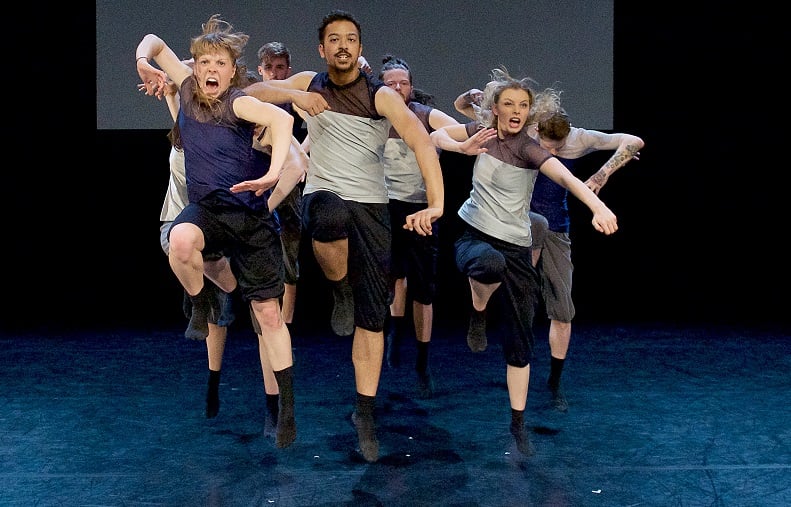
Verve perform Ocean at the Dance UK conference
Photo: Elliott Franks
Dance solutions for the future
Tense and lively discussions at Dance UK’s recent conference will form the basis of a five-year strategy for dance, says Caroline Miller.
Five years ago, it was suggested that Dance UK organise a conference to bring the entire dance sector together, from ballroom to ballet, from managers to teachers, from companies to dancers. I balked at the idea. It was too huge – an impossible concept for such a diverse sector with multiple concerns and silos. But as we joined forces with the Association of Dance of the African Diaspora, Youth Dance England and the National Dance Teachers Association, the idea of a conference bringing the sector together took shape. And we chose to focus on the future to avoid going over the same old complaints without providing solutions.
So, in April, over 650 people converged in London for three and a half days, with over 150 speakers. There were many important and provocative topics covered over the weekend. Dame Gillian Lynne left the audience roaring with laughter on the opening night, but also made an important call to break down the silos between dance forms, and used her 70-year career to inspire ambition and courage in the next generation. A presentation on ‘Dance is Public Health’ from Jan Burkhardt left audiences with much food for thought, as did discussions about the state of dance in education, including an inspiring keynote speech by Sir Ken Robinson from Los Angeles. A panel talking about dancers’ pay, facilitated by Equity, attracted an audience including commercial and independent dancers, funding bodies, artistic directors and students. Throughout the conference, a range of artists inspired audiences with ‘Power Hour’ presentations, our version of TED talks, from Scottish artist Claire Cunningham to Shobana Jeyasingh.
Even when discussions were tense, everyone in the sector cares passionately about giving young dancers the highest standard of training possible
The Mayor of London’s City Hall hosted a morning about dance and philanthropy, including a live dragon’s den for artists and arts organisations to pitch for investment. This was the culmination of our Agile Fundraising training programme, resulting in over £6,500 being raised for prizes. The finale was Harlequin Floors donating a further £10,000 to support our work in dancers’ health.
One of the most significant successes of the conference was the increased profile it gave to dancers’ health. Our Healthier Dancer Programme and the National Institute of Dance Medicine and Science are world-renowned, but the challenge is that despite organising stand-alone dancers’ health events much of the information may not reach beyond those teachers, dancers, health specialists and researchers devoted to dance medicine and science. Having health as an integrated element of the conference allowed a new audience to attend. Two health sessions became the buzz of the conference: the first about periodisation, which proposes a programme of phased goals in dance training (as tested by ArtEZ School of Dance in the Netherlands), and the second a panel discussion on choreographic demands in dance, balancing innovation with the health of dancers.
It would have been impossible to have so many dance professionals in one place without heated debate, and the issue of dance training was one of the main focuses. The final day was dedicated to emerging artists: training, creativity and choreography. What was clear was that even when discussions were tense, everyone in the sector cares passionately about giving young dancers the highest standard of training possible.
It was heartening in the midst of all the debate for delegates to see performances by the National Youth Dance Company and Verve, the post-graduate company of Northern School of Contemporary Dance.
One of the most exciting elements of the conference was its online success. We made a significant investment in filming and live-streaming various elements and over 900 viewers from 27 countries tuned in, watching over 60,000 minutes. These numbers continue to rise as people watch the recorded sessions at www.danceuktv.com and www.artstreamingtv.com. The conference also trended on twitter with over 4,200 tweets, which outstripped our expectations. It shows the importance of live streaming and twitter to reach new people, not only to extend geographic impact but also to help parents with childcare. Some of the most positive feedback came from parents who said they appreciated being able to be involved from home because they hadn’t been able to arrange or afford childcare.
So what next after such a huge and ambitious event? We are using the information from the conference to create a five-year strategy for dance (this is not a political manifesto) which will include our priorities as identified by dance professionals. This will focus on the suggested solutions for solving these challenges, as well as targets and goals for the industry in various areas, from working conditions to artist development. It will be used internally to address the challenges that are within our own power to deal with, as well as areas in which we need support from policy makers. The exciting thing is that this will be the first time that dance professionals have set their own strategy and targets that we will be able to measure progress against in five years’ time.
Caroline Miller is Director of Dance UK.
www.danceuk.org
Join the Discussion
You must be logged in to post a comment.